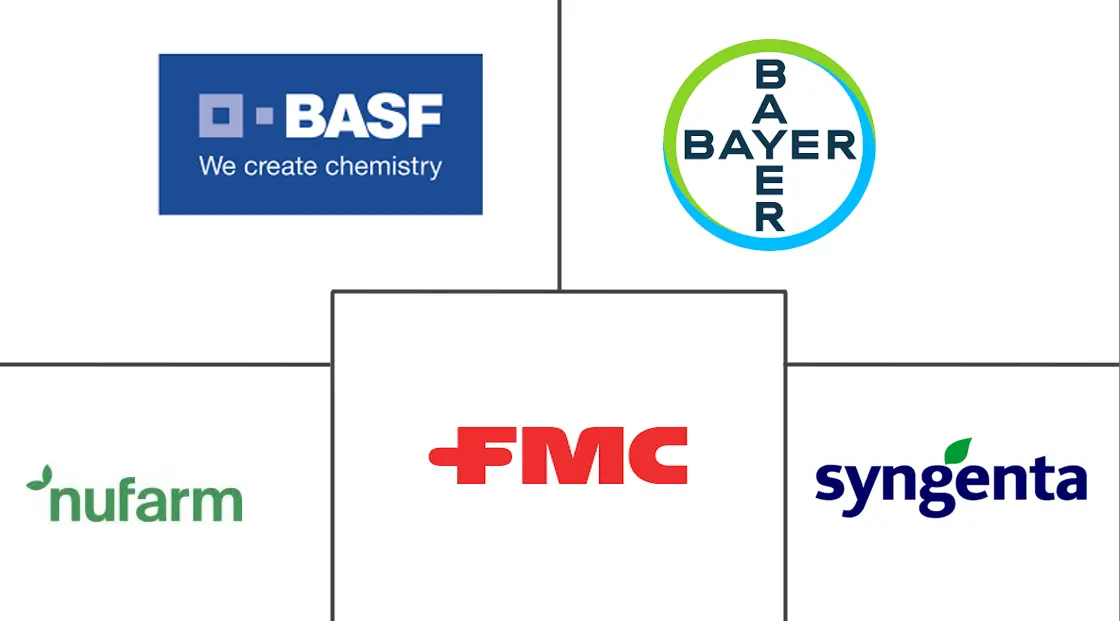Europe Insecticide Market Size and Share
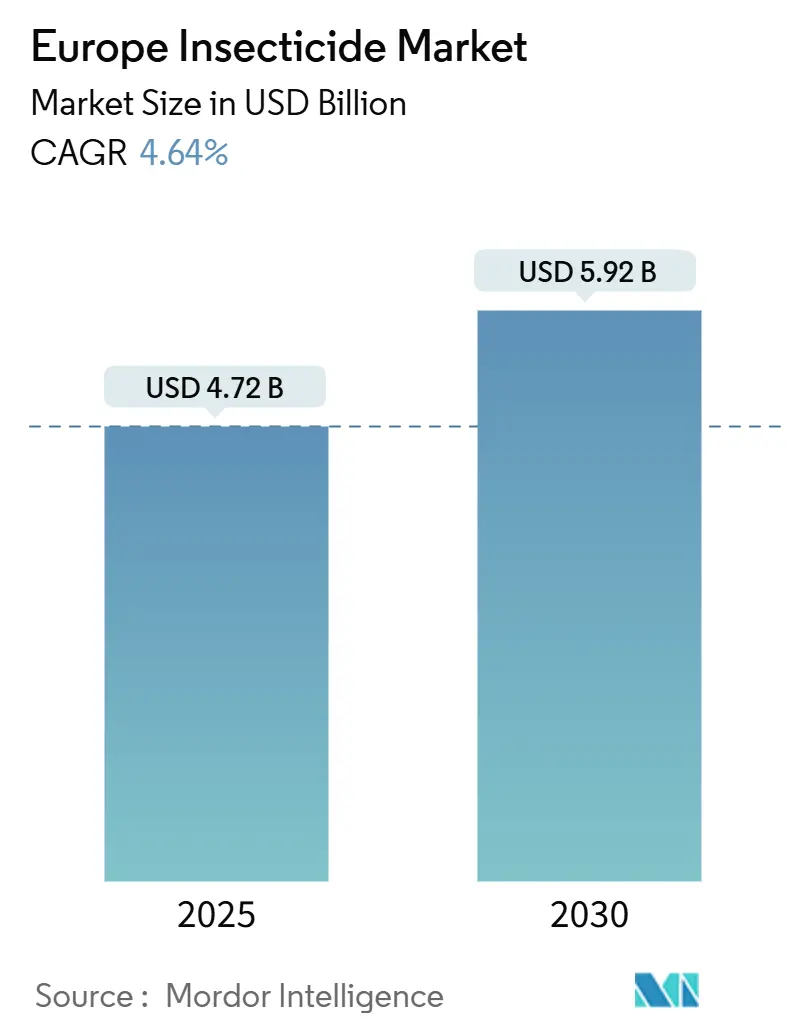
Europe Insecticide Market Analysis by Mordor Intelligence
The Europe insecticide market size reached USD 4.72 billion in 2025 and is forecast to climb to USD 5.92 billion by 2030, advancing at a 4.64% CAGR during 2025-2030. The steady expansion reflects a pivot toward precision application tools, the phase-out of high-toxicity actives, and a climate-driven rise in invasive pests. Growers are directing spending toward foliar products that pair with GPS-guided sprayers, while seed treatment gains traction in integrated pest management programs. Parallel regulatory moves, such as France’s Ecophyto 2030 plan and Germany’s fast-track pathways for biologicals, stimulate demand for low-residue formulations that command price premiums. Contract farming consolidation further enlarges purchase volumes, allowing suppliers to bundle biological and chemical inputs under multi-year agreements that offset compliance costs.
Key Report Takeaways
- By application mode, foliar applications led with 63.6% of Europe insecticide market share in 2024, whereas seed treatment is projected to grow at a 4.9% CAGR through 2030.
- By crop type, grains and cereals accounted for 60.7% of the Europe insecticide market size in 2024 and are set to expand at a 4.7% CAGR to 2030.
- By geography, Germany commanded a 46.7% share of the Europe insecticide market in 2024, while France records the highest forecast growth at 6.4% CAGR through 2030.
Europe Insecticide Market Trends and Insights
Drivers Impact Analysis
| Driver | (~) % Impact on CAGR Forecast | Geographic Relevance | Impact Timeline |
|---|---|---|---|
| Accelerated Europe phase-out of high-toxicity actives | +0.8% | Europe-wide, strongest in Germany and Netherlands | Medium term (2-4 years) |
| Shift to precision-spray equipment boosts per-hectare spend | +0.7% | Germany, France, Netherlands with spillover to Central and Eastern Europe | Short term (≤ 2 years) |
| Climate-led surge in invasive pests in Northern Europe | +0.6% | Northern Europe, expanding southward | Long term (≥ 4 years) |
| Rapid adoption of biological and chemical stacked programs | +0.5% | Europe-wide, led by France and Italy | Medium term (2-4 years) |
| Rise of contract farming consolidates purchase volumes | +0.4% | Central and Eastern Europe, expanding to Western Europe | Medium term (2-4 years) |
| Eco-label demand from retailers favors low-residue insecticides | +0.3% | Western Europe, strongest in Germany and United Kingdom | Short term (≤ 2 years) |
| Source: Mordor Intelligence | |||
Accelerated Europe Phase-Out of High-Toxicity Actives
The European Commission's withdrawal of the Sustainable Use Regulation proposal in February 2024 paradoxically accelerated member state initiatives to restrict high-toxicity active ingredients, creating replacement demand for premium alternatives. France implemented its Ecophyto 2030 plan targeting 50% pesticide reduction while maintaining agricultural productivity, forcing growers toward higher-efficacy formulations that command 20-40% price premiums [1]Source: French Ministry of Agriculture, “Ecophyto Plan,” agriculture.gouv.fr. Germany's Plant Protection Product Modernization Act established fast-track approval pathways for biological alternatives, reducing registration timelines from 36 to 18 months for qualifying products. This regulatory arbitrage creates first-mover advantages for companies with robust biological pipelines, as demonstrated by BASF's accelerated launch of Veltyma fungicide-insecticide combinations across 12 Europe markets in 2024.
Shift to Precision-Spray Equipment Boosts Per-Hectare Spend
Variable-rate application technology adoption reached 23% of European farms by 2024, enabling targeted chemical delivery that increases per-hectare active ingredient utilization by 15-35% while reducing total volume applied. German precision agriculture equipment manufacturer Amazone reported 40% growth in GPS (Global Positioning System)-guided sprayer sales during 2024, driven by CAP subsidies covering up to 60% of equipment costs for farms demonstrating environmental compliance. This technology shift creates a value paradox where total insecticide volumes decline while market value expands through premium pricing for precision-compatible formulations. Companies like Corteva have developed drift-reduction adjuvants specifically for drone applications, capturing 25-30% price premiums over conventional formulations.
Climate-Led Surge in Invasive Pests in Northern Europe
Rising winter temperatures have enabled Mediterranean pest species to establish permanent populations in Northern European growing regions, expanding the addressable market for specialized insecticides by an estimated 12-18% since 2020. The brown marmorated stink bug (Halyomorpha halys) established breeding populations in Germany and the Netherlands during 2024, creating new demand for neonicotinoid alternatives following European restrictions. Fall armyworm detections increased 300% across Scandinavia in 2024, forcing the adoption of Bt-based biological insecticides previously unnecessary in these regions. This geographic expansion particularly benefits companies with broad-spectrum biological portfolios, as conventional chemistries face resistance development in newly established pest populations.
Rapid Adoption of Biological And Chemical Stacked Programs
Integrated biological-chemical programs achieved 35% adoption rates among European commercial growers in 2024, driven by resistance management protocols and retailer sustainability requirements. These stacked applications command 15-25% price premiums over single-mode treatments while extending chemical efficacy cycles by 2-3 seasons through resistance dilution. Koppert Biological Systems reported 60% growth in European sales of Spidex biological mite control products used in combination with reduced-rate synthetic acaricides. The stacking trend particularly benefits companies with dual biological-chemical portfolios, creating cross-selling opportunities and customer retention advantages. Regulatory frameworks increasingly favor integrated approaches, with EFSA's (European Food Safety Authority) 2024 guidance documents providing expedited review pathways for combination products demonstrating synergistic efficacy at reduced individual component rates.
Restraints Impact Analysis
| Restraint | (~) % Impact on CAGR Forecast | Geographic Relevance | Impact Timeline |
|---|---|---|---|
| Draft Europe sustainable use regulation pesticide-cut targets | -1.2% | Europe-wide, strongest in the Netherlands and Denmark | Long term (≥ 4 years) |
| Escalating actives-registration costs deter innovation | -0.8% | Europe-wide, particularly affecting small and mid-sized enterprises | Medium term (2-4 years) |
| Growing resistance in coleopteran and lepidopteran species | -0.6% | Central and Eastern Europe, expanding westward | Medium term (2-4 years) |
| Labor shortages limiting optimal field application windows | -0.4% | Western Europe, acute in Germany and the Netherlands | Short term (≤ 2 years) |
| Source: Mordor Intelligence | |||
Draft Europe Sustainable Use Regulation Pesticide-cut Targets
Although the European Commission withdrew its Sustainable Use Regulation proposal in February 2024, individual member states continue implementing national pesticide reduction targets that constrain market growth potential. The Netherlands maintains its 2030 goal of 50% pesticide use reduction, while Denmark targets a 40% reduction by 2027 through its Pesticide Strategy 2022-2026 [2]Source: Danish Environmental Protection Agency, “Pesticide Strategy,” eng.mst.dk. These national initiatives create regulatory fragmentation that complicates market access strategies and increases compliance costs for multinational manufacturers. France's Ecophyto 2030 plan specifically targets insecticide volume reductions of 25% while maintaining agricultural productivity, forcing adoption of higher-efficacy alternatives that may not offset volume declines in revenue terms.
Escalating Active Registration Costs Deter Innovation
EFSA (European Food Safety Authority) registration costs for new active ingredients reached EUR 350,000 (USD 380,000) per dossier in 2024, representing a 40% increase from 2020 levels and effectively pricing smaller companies out of innovation cycles. The comprehensive data requirements under Regulation 1107/2009 now demand extensive environmental fate studies, endocrine disruption assessments, and pollinator impact evaluations that can extend development timelines to 12-15 years. This cost inflation particularly constrains biological innovation, as microbial and botanical products require specialized testing protocols not covered by standard toxicology frameworks.
Segment Analysis
By Application Mode: Precision Technology Drives Foliar Dominance
Foliar applications command 63.6% market share in 2024, reflecting the segment's compatibility with precision spray technologies that optimize chemical delivery efficiency and regulatory compliance. The dominance stems from variable-rate application systems that enable targeted pest control while minimizing off-target exposure, addressing both efficacy and environmental concerns. The adoption of modern agricultural practices like precision application and the increasing awareness of sustainable farming techniques across European countries have substantially contributed to this segment's dominance. The segment's success is further reinforced by its proven efficacy in protecting various other crops, including pulses, oilseeds, fruits, and vegetables, which are particularly susceptible to pest infestations. The use of liquid insecticides in foliar applications enhances their effectiveness and adaptability.
Seed treatment emerges as the fastest-growing segment at 4.9% CAGR through 2030, driven by integrated pest management protocols that provide season-long protection with reduced environmental exposure. Seed treatment rising popularity is particularly evident in its application for cereals, such as wheat, maize, and barley, which are commonly grown in monoculture. The high density and uniformity of cereal crops can facilitate the rapid spread of pests within a field, making preventive seed treatment increasingly crucial. The segment's growth is further supported by its precise application methodology, which ensures targeted pest control while minimizing environmental impact, aligning with Europe's growing focus on sustainable agricultural practices.
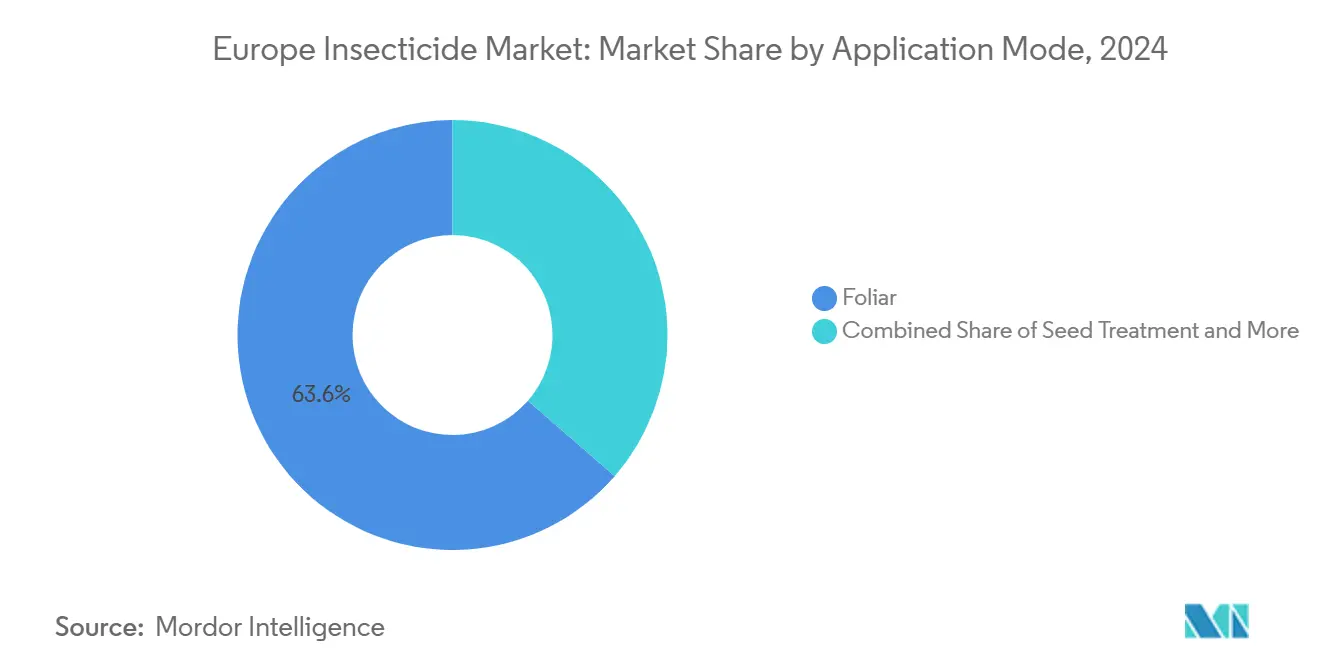
Note: Segment shares of all individual segments available upon report purchase
By Crop Type: Cereals Drive Volume While Specialties Command Premiums
Grains and cereals dominate with 60.7% market share in 2024 and lead growth at 4.7% CAGR through 2030, supported by Europe's 127 million hectares of cereal production and intensifying pest pressure from climate-driven species migration. This growth is primarily driven by its effectiveness against soil-borne diseases and pests like wireworms, cabbage root flies, carrot flies, onion flies, and Colorado potato beetles. The segment benefits from standardized application protocols and economies of scale in chemical procurement, while facing increasing pressure from cereal aphid resistance to pyrethroid chemistries.
The method's rising popularity is particularly evident in its application for cereals, such as wheat, maize, and barley, which are commonly grown in monoculture. The high density and uniformity of cereal crops can facilitate the rapid spread of pests within a field, making preventive seed treatment increasingly crucial. The segment's growth is further supported by its precise application methodology, which ensures targeted pest control while minimizing environmental impact, aligning with Europe's growing focus on sustainable agricultural practices. The integration of biological insecticide solutions in seed treatment methods is enhancing its appeal among environmentally conscious farmers.
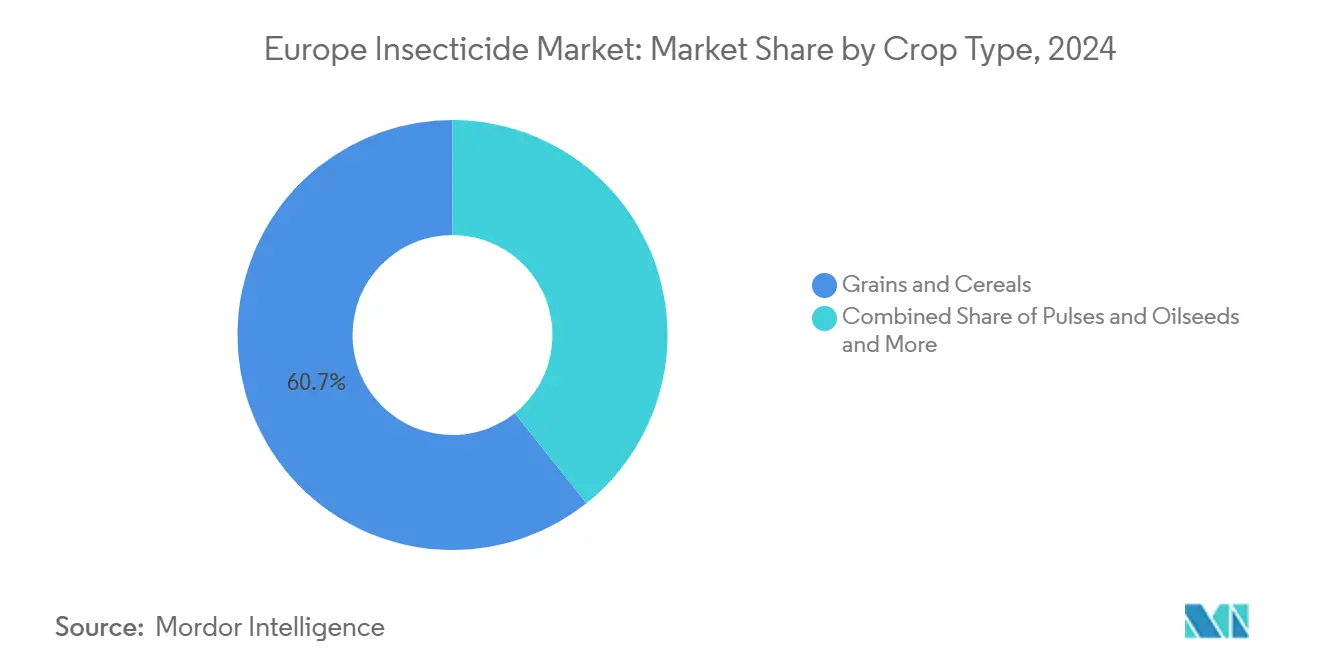
Note: Segment shares of all individual segments available upon report purchase
Geography Analysis
Germany commands 46.7% market share in 2024, reflecting the country's intensive agricultural practices, early precision technology adoption, and robust regulatory framework that supports innovation in sustainable pest management. The German market benefits from strong agricultural cooperatives that facilitate bulk purchasing and technology transfer, while maintaining premium pricing for environmentally compliant formulations. German growers increasingly adopt biological-chemical stacking programs, with 42% of cereal producers implementing integrated protocols by 2024, driving demand for premium formulations that command 20-30% price premiums over conventional treatments. The country's Federal Office of Consumer Protection and Food Safety maintains expedited review pathways for low-risk active ingredients, reducing registration timelines and encouraging innovation in sustainable pest management solutions [3]Source: German Federal Ministry of Food and Agriculture, “Plant Protection,” bmel.de.
France emerges as the fastest-growing market at 6.4% CAGR through 2030, driven by the Ecophyto 2030 program's emphasis on biological integration and precision application technologies that enable pesticide reduction while maintaining productivity. The French agricultural sector's commitment to maintaining high crop quality standards has driven the adoption of advanced insecticide application technologies. The country's research institutions actively collaborate with industry players to develop more effective and environmentally sustainable insecticide solutions. This focus on innovation, combined with the growing need for crop protection, has established France as a key player in the European insecticide market.
The United Kingdom maintains a significant market share post-Brexit, with regulatory alignment to European standards preserving market access for established formulations. Russia and Ukraine's combined market share faces ongoing disruption from geopolitical tensions, creating supply chain uncertainties that benefit Western European production capacity. These markets increasingly emphasize biological integration, with regulatory frameworks providing fast-track approval for combination products that demonstrate synergistic efficacy at reduced individual component rates.
Competitive Landscape
The Europe insecticide market exhibits moderate concentration, with the top five players including Syngenta Group, BASF SE, FMC Corporation, Bayer AG, and Nufarm Ltd. The European insecticide market structure is characterized by the strong presence of large multinational agricultural science companies that possess extensive product portfolios and significant research capabilities. These established players leverage their global presence, technical expertise, and long-standing relationships with distributors and farmers to maintain their market positions. The market demonstrates a relatively high level of consolidation, with the top companies controlling a substantial portion of the market share through their comprehensive product offerings and established brand recognition.
The competitive landscape has been shaped by several strategic mergers and acquisitions, as companies seek to enhance their technological capabilities and expand their geographic presence. These consolidation activities have resulted in the formation of stronger entities with improved research capabilities and broader product portfolios. Local players maintain their presence in specific regional markets through specialized product offerings and strong distribution networks, though their market influence remains limited compared to global leaders. The industry's high entry barriers, including substantial research and development investments and stringent regulatory requirements, have contributed to maintaining the existing market structure.
Success in the European agricultural insecticide market increasingly depends on companies' ability to develop sustainable and environmentally friendly solutions while maintaining product efficacy. Market leaders must focus on developing novel active ingredients and formulations that address emerging pest resistance issues while meeting stringent environmental regulations. Companies need to invest in digital farming technologies and integrated pest management solutions to provide comprehensive crop protection chemical packages. Building strong relationships with distributors and farmers through technical support and education programs is becoming increasingly crucial for maintaining market share.
Europe Insecticide Industry Leaders
-
Syngenta Group
-
BASF SE
-
FMC Corporation
-
Bayer AG
-
Nufarm Ltd.
- *Disclaimer: Major Players sorted in no particular order
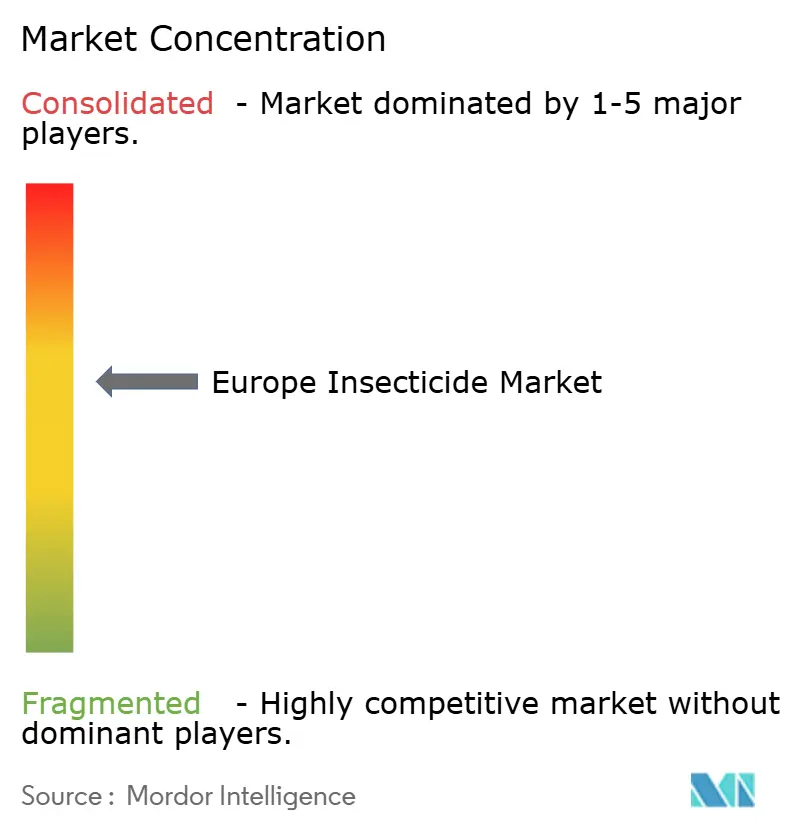
Recent Industry Developments
- January 2023: Bayer formed a new partnership with Oerth Bio to enhance crop protection technology and create more eco-friendly crop protection solutions.
- August 2022: Syngenta introduced Acelepryn, a novel insecticide for the control of white worms in lawns. The product can be used in sports courts, golf courses, racecourses, bowling fields, and aerodromes, and for professional application in commercial and residential lawns.
- June 2022: Corteva Agriscience launched a new insecticide called Geronimo. The product is effective against important pests, especially certain lepidoptera, rigidoptera, bedbugs, and ticks.
Europe Insecticide Market Report Scope
Chemigation, Foliar, Fumigation, Seed Treatment, Soil Treatment are covered as segments by Application Mode. Commercial Crops, Fruits & Vegetables, Grains & Cereals, Pulses & Oilseeds, Turf & Ornamental are covered as segments by Crop Type. France, Germany, Italy, Netherlands, Russia, Spain, Ukraine, United Kingdom are covered as segments by Country.| Foliar |
| Seed Treatment |
| Soil Treatment |
| Chemigation |
| Fumigation |
| Commercial Crops |
| Fruits & Vegetables |
| Grains & Cereals |
| Pulses & Oilseeds |
| Turf & Ornamental |
| Germany |
| France |
| Spain |
| Russia |
| Italy |
| United Kingdom |
| Netherlands |
| Ukraine |
| Rest of Europe |
| Application Mode | Foliar |
| Seed Treatment | |
| Soil Treatment | |
| Chemigation | |
| Fumigation | |
| Crop Type | Commercial Crops |
| Fruits & Vegetables | |
| Grains & Cereals | |
| Pulses & Oilseeds | |
| Turf & Ornamental | |
| Geography | Germany |
| France | |
| Spain | |
| Russia | |
| Italy | |
| United Kingdom | |
| Netherlands | |
| Ukraine | |
| Rest of Europe |
Market Definition
- Function - Insecticides are chemicals used to control or prevent insects from damaging the crop and prevent yield loss.
- Application Mode - Foliar, Seed Treatment, Soil Treatment, Chemigation, and Fumigation are the different type of application modes through which crop protection chemicals are applied to the crops.
- Crop Type - This represents the consumption of crop protection chemicals by Cereals, Pulses, Oilseeds, Fruits, Vegetables, Turf, and Ornamental crops.
| Keyword | Definition |
|---|---|
| IWM | Integrated weed management (IWM) is an approach to incorporate multiple weed control techniques throughout the growing season to give producers the best opportunity to control problematic weeds. |
| Host | Hosts are the plants that form relationships with beneficial microorganisms and help them colonize. |
| Pathogen | A disease-causing organism. |
| Herbigation | Herbigation is an effective method of applying herbicides through irrigation systems. |
| Maximum residue levels (MRL) | Maximum Residue Limit (MRL) is the maximum allowed limit of pesticide residue in food or feed obtained from plants and animals. |
| IoT | The Internet of Things (IoT) is a network of interconnected devices that connect and exchange data with other IoT devices and the cloud. |
| Herbicide-tolerant varieties (HTVs) | Herbicide-tolerant varieties are plant species that have been genetically engineered to be resistant to herbicides used on crops. |
| Chemigation | Chemigation is a method of applying pesticides to crops through an irrigation system. |
| Crop Protection | Crop protection is a method of protecting crop yields from different pests, including insects, weeds, plant diseases, and others that cause damage to agricultural crops. |
| Seed Treatment | Seed treatment helps to disinfect seeds or seedlings from seed-borne or soil-borne pests. Crop protection chemicals, such as fungicides, insecticides, or nematicides, are commonly used for seed treatment. |
| Fumigation | Fumigation is the application of crop protection chemicals in gaseous form to control pests. |
| Bait | A bait is a food or other material used to lure a pest and kill it through various methods, including poisoning. |
| Contact Fungicide | Contact pesticides prevent crop contamination and combat fungal pathogens. They act on pests (fungi) only when they come in contact with the pests. |
| Systemic Fungicide | A systemic fungicide is a compound taken up by a plant and then translocated within the plant, thus protecting the plant from attack by pathogens. |
| Mass Drug Administration (MDA) | Mass drug administration is the strategy to control or eliminate many neglected tropical diseases. |
| Mollusks | Mollusks are pests that feed on crops, causing crop damage and yield loss. Mollusks include octopi, squid, snails, and slugs. |
| Pre-emergence Herbicide | Preemergence herbicides are a form of chemical weed control that prevents germinated weed seedlings from becoming established. |
| Post-emergence Herbicide | Postemergence herbicides are applied to the agricultural field to control weeds after emergence (germination) of seeds or seedlings. |
| Active Ingredients | Active ingredients are the chemicals in pesticide products that kill, control, or repel pests. |
| United States Department of Agriculture (USDA) | The Department of Agriculture provides leadership on food, agriculture, natural resources, and related issues. |
| Weed Science Society of America (WSSA) | The WSSA, a non-profit professional society, promotes research, education, and extension outreach activities related to weeds. |
| Suspension concentrate | Suspension concentrate (SC) is one of the formulations of crop protection chemicals with solid active ingredients dispersed in water. |
| Wettable powder | A wettable powder (WP) is a powder formulation that forms a suspension when mixed with water prior to spraying. |
| Emulsifiable concentrate | Emulsifiable concentrate (EC) is a concentrated liquid formulation of pesticide that needs to be diluted with water to create a spray solution. |
| Plant-parasitic nematodes | Parasitic Nematodes feed on the roots of crops, causing damage to the roots. These damages allow for easy plant infestation by soil-borne pathogens, which results in crop or yield loss. |
| Australian Weeds Strategy (AWS) | The Australian Weeds Strategy, owned by the Environment and Invasives Committee, provides national guidance on weed management. |
| Weed Science Society of Japan (WSSJ) | WSSJ aims to contribute to the prevention of weed damage and the utilization of weed value by providing the chance for research presentation and information exchange. |
Research Methodology
Mordor Intelligence follows a four-step methodology in all our reports.
- Step-1: Identify Key Variables: In order to build a robust forecasting methodology, the variables and factors identified in Step-1 are tested against available historical market numbers. Through an iterative process, the variables required for market forecast are set and the model is built on the basis of these variables.
- Step-2: Build a Market Model: Market-size estimations for the forecast years are in nominal terms. Inflation is not a part of the pricing, and the average selling price (ASP) is kept constant throughout the forecast period.
- Step-3: Validate and Finalize: In this important step, all market numbers, variables and analyst calls are validated through an extensive network of primary research experts from the market studied. The respondents are selected across levels and functions to generate a holistic picture of the market studied.
- Step-4: Research Outputs: Syndicated Reports, Custom Consulting Assignments, Databases & Subscription Platforms
